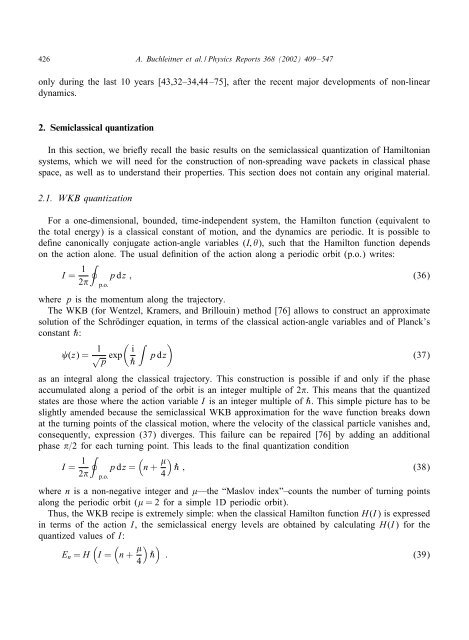Non-dispersive wave packets in periodically driven quantum systems
Non-dispersive wave packets in periodically driven quantum systems
Non-dispersive wave packets in periodically driven quantum systems
Create successful ePaper yourself
Turn your PDF publications into a flip-book with our unique Google optimized e-Paper software.
426 A. Buchleitner et al. / Physics Reports 368 (2002) 409–547<br />
only dur<strong>in</strong>g the last 10 years [43,32–34,44–75], after the recent major developments of non-l<strong>in</strong>ear<br />
dynamics.<br />
2. Semiclassical quantization<br />
In this section, we brie y recall the basic results on the semiclassical quantization of Hamiltonian<br />
<strong>systems</strong>, which we will need for the construction of non-spread<strong>in</strong>g <strong>wave</strong> <strong>packets</strong> <strong>in</strong> classical phase<br />
space, as well as to understand their properties. This section does not conta<strong>in</strong> any orig<strong>in</strong>al material.<br />
2.1. WKB quantization<br />
For a one-dimensional, bounded, time-<strong>in</strong>dependent system, the Hamilton function (equivalent to<br />
the total energy) is a classical constant of motion, and the dynamics are periodic. It is possible to<br />
de ne canonically conjugate action-angle variables (I; ), such that the Hamilton function depends<br />
on the action alone. The usual de nition of the action along a periodic orbit (p.o.) writes:<br />
I = 1<br />
2<br />
<br />
p dz ; (36)<br />
p:o:<br />
where p is the momentum along the trajectory.<br />
The WKB (for Wentzel, Kramers, and Brillou<strong>in</strong>) method [76] allows to construct an approximate<br />
solution of the Schrod<strong>in</strong>ger equation, <strong>in</strong> terms of the classical action-angle variables and of Planck’s<br />
constant ˝:<br />
(z)= 1<br />
<br />
i<br />
√ exp<br />
p ˝<br />
<br />
<br />
p dz<br />
as an <strong>in</strong>tegral along the classical trajectory. This construction is possible if and only if the phase<br />
accumulated along a period of the orbit is an <strong>in</strong>teger multiple of 2 . This means that the quantized<br />
states are those where the action variable I is an <strong>in</strong>teger multiple of ˝. This simple picture has to be<br />
slightly amended because the semiclassical WKB approximation for the <strong>wave</strong> function breaks down<br />
at the turn<strong>in</strong>g po<strong>in</strong>ts of the classical motion, where the velocity of the classical particle vanishes and,<br />
consequently, expression (37) diverges. This failure can be repaired [76] by add<strong>in</strong>g an additional<br />
phase =2 for each turn<strong>in</strong>g po<strong>in</strong>t. This leads to the nal quantization condition<br />
I = 1<br />
<br />
p dz = n + ˝ ; (38)<br />
2 p:o:<br />
4<br />
where n is a non-negative <strong>in</strong>teger and —the “Maslov <strong>in</strong>dex”–counts the number of turn<strong>in</strong>g po<strong>in</strong>ts<br />
along the periodic orbit ( = 2 for a simple 1D periodic orbit).<br />
Thus, the WKB recipe is extremely simple: when the classical Hamilton function H(I) is expressed<br />
<strong>in</strong> terms of the action I, the semiclassical energy levels are obta<strong>in</strong>ed by calculat<strong>in</strong>g H(I) for the<br />
quantized values of I:<br />
<br />
En = H I = n + ˝ : (39)<br />
4<br />
(37)











